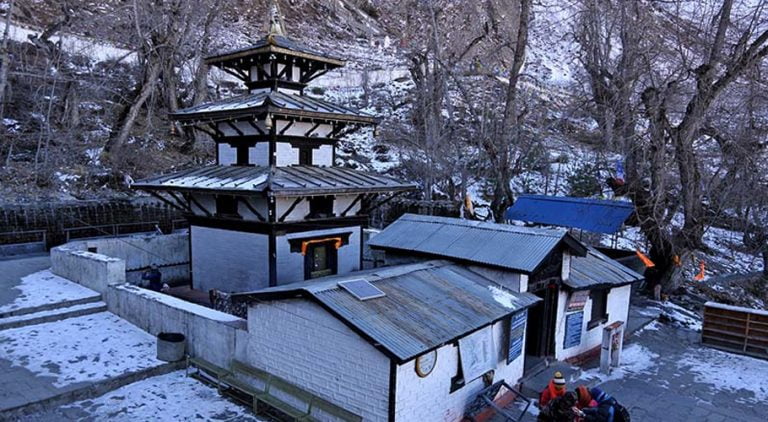
Muktinath is a highly venerated sacred site located at an altitude of 3,710 meters (12,172 ft) at the base of Thorongla pass mountain pass in mustang district. The word Muktinath has been derived from two Nepali words “Mukti” & “Nath”. Mukti means Salvation or nirvana whereas Nath means God or master signifying the place as the center for salvation. The site is also known as Mukti Kshetra by Hindus, which literally means the “place of salvation” and it is one of the most ancient temples of the God Vishnu and the Vaishnava tradition in Nepal.Thus Muktinath holds its own Sanskrit significance and a emotional feeling attached to it. It can be reached from Pokhara passing through beni bazaar by road or directly form Kathmandu to Jomsom airport and by a reserved vehicle from Jomsom. This region is also popularly known as “Himalpaari ko desh” meaning the land beyond the mountains.
History:
Buddhists call Muktinath Chumming Gyatsa, which in Tibetan means ‘Hundred Waters’.ChumigGyatsa is a sacred site of the Dakinis goddesses known as Sky Dancers, as well as one of the 24 famous Tantric sites, according to Tibetan Buddhism. Furthermore, the location is thought to be a manifestation of Avalokitesvara, the Bodhisattva of Compassion and Virtue. According to Tibetan Buddhist tradition, the founder of Tibetan Buddhism, Guru Rim poche, also known as Padmasambhava, meditated here on his route to Tibet.
The shrine is considered to be one of the eight sacred places which is believed to have arisen on its own known as SvayamVyaktaKsetras (Srirangam, Srimushnam, Tirupati, Naimisharanya, Totadri, Pushkar, and Badrinath are the other seven of these shrine), as well as one of Lord Vishnu’s 108 Divya Desam (holy places of worship). It’s also believed to be one of the 51 Shakti Pitha goddess destinations.
Vicinity& Major attractions:
The temple is small, with a human-sized golden statue of Vishnu as Shri Mukti Narayana inside. Aside from Mukti Narayana, the temple also houses bronze images of Bhoodevi (the Earth-goddess version of Lakshmi), the goddesses Saraswati and Janaki (Sita), Garuda (Vishnu’s steed), Lava-Kusa (Rama and Sita’s sons), and the Sapta Rishis (Seven Sages created by Lord Brahma). The temple is staffed by an elderly Buddhist monk, and worship is led by Buddhist nuns.
According to myths in Hinduism, the cycle of life is a vicious cycle or illusion and the ultimate goal of one’s life is to be rid of this cycle and attain salvation. It is highly believed that a visit to Muktinath temple might help in achieving this. A semi-circular wall with 108 stone faucets at a height of seven feet surrounds the temple. The faucets are approximately one foot apart and all have the shape of a bull’s head. Water from the icy Kali Gandaki River has been channelled to flow through the mouths of these bulls, and intrepid pilgrims who visit the temple frequently stand beneath each of the spouts.The Kali Gantaki riverbed downstream from Muktinath is the only place on the planet where you can find the rare Shaligram stones needed to build a Vishnu temple.
The diverse landscape and culture found along the route to Muktinath gives marvelous insight into the way of life of Nepali people of various ethnic groups.The Annapurna circuit and Annapurna foothill hikes cover the majority of the route along the Jomsom trip.Extreme wind is caused by differences in atmospheric pressure between the Tibetan plateau and the lower reaches of the valley. The best example of the unique architecture of this region is found in the village of Marpha which is a two-hour walk down from Jomsom.
In short, Muktinath region is one of the most popular and visited religious and tourist destination of Western Nepal and has been on a continuous state of attracting more internal and external visitors due to its beautiful landscape and immense religious significance.
-Article written by: Ujjwal Bhetwal for Land Nepal